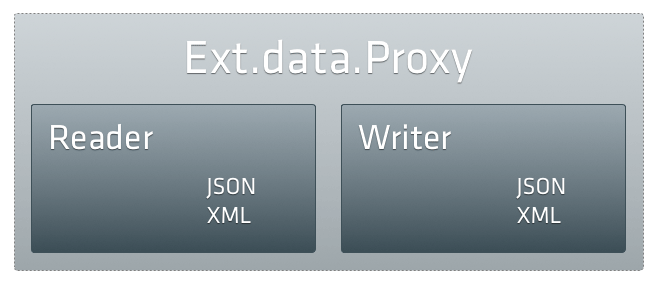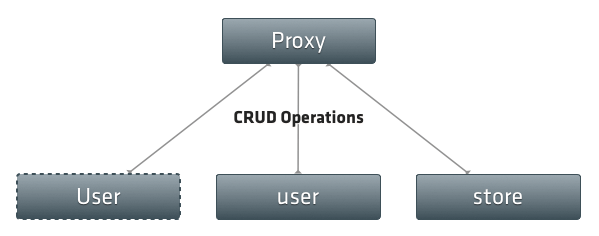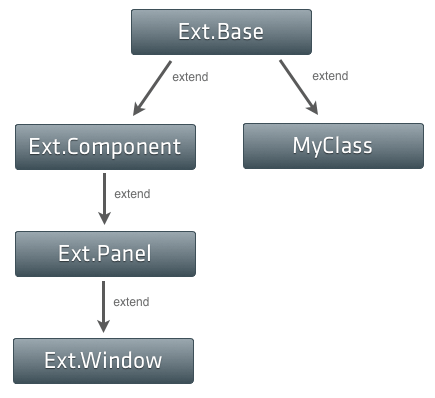One of the classes that has a lot more prominence in Ext JS 4 is the data Proxy. Proxies are responsible for all of the loading and saving of data in an Ext JS 4 or Sencha Touch application. Whenever you're creating, updating, deleting or loading any type of data in your app, you're almost certainly doing it via an Ext.data.Proxy.
If you've seen January's Sencha newsletter you may have read an article called Anatomy of a Model, which introduces the most commonly-used Proxies. All a Proxy really needs is four functions - create, read, update and destroy. For an AjaxProxy, each of these will result in an Ajax request being made. For a LocalStorageProxy, the functions will create, read, update or delete records from HTML5 localStorage.
Because Proxies all implement the same interface they're completely interchangeable, so you can swap out your data source - at design time or run time - without changing any other code. Although the local Proxies like LocalStorageProxy and MemoryProxy are self-contained, the remote Proxies like AjaxProxy and ScriptTagProxy make use of Readers and Writers to encode and decode their data when communicating with the server.

Whether we are reading data from a server or preparing data to be sent back, usually we format it as either JSON or XML. Both of our frameworks come with JSON and XML Readers and Writers which handle all of this for you with a very simple API.
Using a Proxy with a Model
Proxies are usually used along with either a Model or a Store. The simplest setup is just with a model:
var User = Ext.regModel('User', {
fields: ['id', 'name', 'email'],
proxy: {
type: 'rest',
url : '/users',
reader: {
type: 'json',
root: 'users'
}
}
});
var User = Ext.regModel('User', {
fields: ['id', 'name', 'email'],
proxy: {
type: 'rest',
url : '/users',
reader: {
type: 'json',
root: 'users'
}
}
});
Here we've created a User model with a RestProxy. RestProxy is a special form of AjaxProxy that can automatically figure out Restful urls for our models. The Proxy that we set up features a JsonReader to decode any server responses - check out the recent data package post on the Sencha blog to see Readers in action.
When we use the following functions on the new User model, the Proxy is called behind the scenes:
var user = new User({name: 'Ed Spencer'});
//CREATE: calls the RestProxy's create function because the user has never been saved
user.save();
//UPDATE: calls the RestProxy's update function because it has been saved before
user.set('email', 'ed@sencha.com');
//DESTROY: calls the RestProxy's destroy function
user.destroy();
//READ: calls the RestProxy's read function
User.load(123, {
success: function(user) {
console.log(user);
}
});
var user = new User({name: 'Ed Spencer'});
//CREATE: calls the RestProxy's create function because the user has never been saved
user.save();
//UPDATE: calls the RestProxy's update function because it has been saved before
user.set('email', 'ed@sencha.com');
//DESTROY: calls the RestProxy's destroy function
user.destroy();
//READ: calls the RestProxy's read function
User.load(123, {
success: function(user) {
console.log(user);
}
});
We were able to perform all four CRUD operations just by specifying a Proxy for our Model. Notice that the first 3 calls are instance methods whereas the fourth (User.load) is static on the User model. Note also that you can create a Model without a Proxy, you just won't be able to persist it.
Usage with Stores
In Ext JS 3.x, most of the data manipulation was done via Stores. A chief purpose of a Store is to be a local subset of some data plus delta. For example, you might have 1000 products in your database and have 25 of them loaded into a Store on the client side (the local subset). While operating on that subset, your user may have added, updated or deleted some of the Products. Until these changes are synchronized with the server they are known as a delta.
In order to read data from and sync to the server, Stores also need to be able to call those CRUD operations. We can give a Store a Proxy in the same way:
var store = new Ext.data.Store({
model: 'User',
proxy: {
type: 'rest',
url : '/users',
reader: {
type: 'json',
root: 'users'
}
}
});
var store = new Ext.data.Store({
model: 'User',
proxy: {
type: 'rest',
url : '/users',
reader: {
type: 'json',
root: 'users'
}
}
});
We created the exact same Proxy for the Store because that's how our server side is set up to deliver data. Because we'll usually want to use the same Proxy mechanism for all User manipulations, it's usually best to just define the Proxy once on the Model and then simply tell the Store which Model to use. This automatically picks up the User model's Proxy:
//no need to define proxy - this will reuse the User's Proxy
var store = new Ext.data.Store({
model: 'User'
});
//no need to define proxy - this will reuse the User's Proxy
var store = new Ext.data.Store({
model: 'User'
});
Store invokes the CRUD operations via its load and sync functions. Calling load uses the Proxy's read operation, which sync utilizes one or more of create, update and destroy depending on the current Store delta.
//CREATE: calls the RestProxy's create function to create the Tommy record on the server
store.add({name: 'Tommy Maintz'});
store.sync();
//UPDATE: calls the RestProxy's update function to update the Tommy record on the server
store.getAt(1).set('email', 'tommy@sencha.com');
store.sync();
//DESTROY: calls the RestProxy's destroy function
store.remove(store.getAt(1));
store.sync();
//READ: calls the RestProxy's read function
store.load();
//CREATE: calls the RestProxy's create function to create the Tommy record on the server
store.add({name: 'Tommy Maintz'});
store.sync();
//UPDATE: calls the RestProxy's update function to update the Tommy record on the server
store.getAt(1).set('email', 'tommy@sencha.com');
store.sync();
//DESTROY: calls the RestProxy's destroy function
store.remove(store.getAt(1));
store.sync();
//READ: calls the RestProxy's read function
store.load();
Store has used the exact same CRUD operations on the shared Proxy. In all of the examples above we have used the exact same RestProxy instance from three different places: statically on our Model (User.load), as a Model instance method (user.save, user.destroy) and via a Store instance (store.load, store.sync):

Of course, most Proxies have their own private methods to do the actual work, but all a Proxy needs to do is implement those four functions to be usable with Ext JS 4 and Sencha Touch. This means it's easy to create new Proxies, as James Pearce did in a recent Sencha Touch example where he needed to read address book data from a mobile phone. Everything he does to set up his Proxy in the article (about 1/3rd of the way down) works the same way for Ext JS 4 too.








